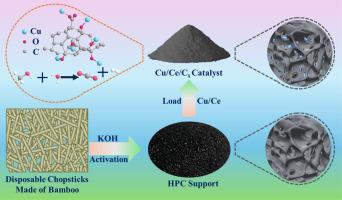Hierarchical porous carbon supports: construction, mechanism, and catalytic performance as efficient microreactors for methanol steam reforming
IF 5.4
3区 化学
Q1 CHEMISTRY, INORGANIC & NUCLEAR
引用次数: 0
Abstract
In this study, hierarchical porous carbon (HPC) supports were prepared from disposable chopsticks by KOH activation, followed by loading Cu/Ce active components for methanol steam reforming (MSR). It was found that the KOH activation conditions had a significant effect on the pore structure and surface functional groups of the HPC supports. Specifically, at a KOH impregnation ratio of 5:1 and activation time of 3 h, the prepared C8 support exhibited a high specific surface area and a well-developed microporous structure. After impregnation with Cu/Ce, the catalysts exhibited exceptional performance in MSR, with the 20 % Cu2/Ce1/C8 catalysts achieving the highest hydrogen yield of 17,753 μmol·g−1·h−1 at 250 °C. The catalysts were systematically characterized to correlate their structural properties with performance,and a “microporous reactor” mechanism was proposed. Specifically, the well-defined microporous architecture enhanced reactant adsorption through size-selective confinement effects, promotes efficient catalytic conversion via spatial confinement of active species, and suppresses nanoparticle agglomeration through physical immobilization within the porous matrix. This synergistic interplay of adsorption-reaction-stabilization processes significantly enhances both the catalytic activity and long-term stability of the catalysts.

分级多孔碳载体:结构、机制和催化性能作为甲醇蒸汽重整的高效微反应器
本研究以一次性筷子为原料,通过KOH活化制备了层次化多孔碳(HPC)载体,然后将Cu/Ce活性组分加载到甲醇蒸汽重整(MSR)中。结果表明,KOH活化条件对HPC支架的孔结构和表面官能团有显著影响。在KOH浸渍比为5:1、活化时间为3 h的条件下,制备的C8载体具有较高的比表面积和发育良好的微孔结构。经Cu/Ce浸渍后,催化剂表现出优异的MSR性能,其中20% Cu2/Ce1/C8催化剂在250℃时的产氢率最高,为17753 μmol·g−1·h−1。系统表征了催化剂的结构与性能,并提出了“微孔反应器”机理。具体来说,明确定义的微孔结构通过尺寸选择限制效应增强了反应物的吸附,通过活性物质的空间限制促进了有效的催化转化,并通过在多孔基质内的物理固定来抑制纳米颗粒的团聚。这种吸附-反应-稳定过程的协同相互作用显著提高了催化剂的催化活性和长期稳定性。
本文章由计算机程序翻译,如有差异,请以英文原文为准。
求助全文
约1分钟内获得全文
求助全文
来源期刊

Inorganic Chemistry Communications
化学-无机化学与核化学
CiteScore
5.50
自引率
7.90%
发文量
1013
审稿时长
53 days
期刊介绍:
Launched in January 1998, Inorganic Chemistry Communications is an international journal dedicated to the rapid publication of short communications in the major areas of inorganic, organometallic and supramolecular chemistry. Topics include synthetic and reaction chemistry, kinetics and mechanisms of reactions, bioinorganic chemistry, photochemistry and the use of metal and organometallic compounds in stoichiometric and catalytic synthesis or organic compounds.
 求助内容:
求助内容: 应助结果提醒方式:
应助结果提醒方式:


